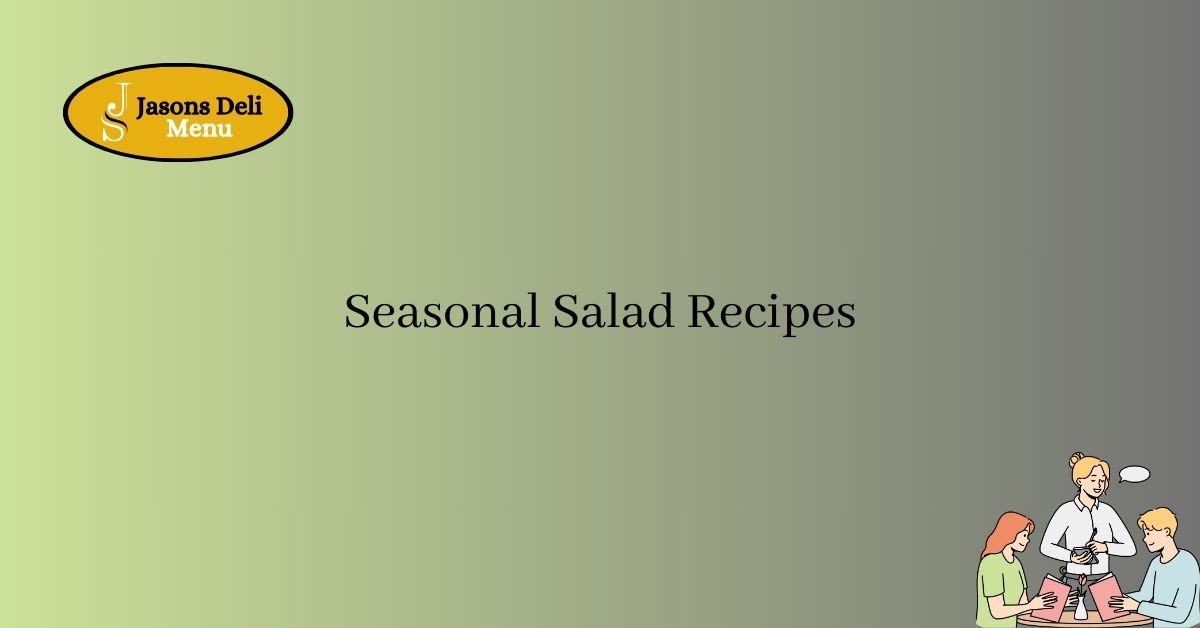Seasonal Salad Recipes
Seasonal salad recipes provide a refreshing way to incorporate the vibrant flavors of each season into your meals. With an abundance of fresh produce available throughout the year, these recipes allow for creativity and variety, ensuring that your salads are not only nutritious but also visually appealing. By focusing on seasonal ingredients, you can enhance the taste and nutritional value of your dishes while supporting local farmers and reducing your carbon footprint. Whether you’re looking for a light lunch or a colorful side dish for dinner, seasonal salads can fit seamlessly into any meal plan.
Incorporating seasonal produce into your salads means that you are utilizing ingredients at their peak freshness, which can significantly enhance the flavor profile of your dishes. From crisp greens in the spring to hearty root vegetables in the fall, there is a wide variety of options to explore. Moreover, seasonal salad recipes can be easily adapted to fit dietary preferences, allowing for vegan, gluten-free, or protein-packed variations. As you navigate through different seasons, consider integrating elements from Jason’s Deli menu which often highlights fresh and wholesome ingredients, making it easier to create delightful salads that are both satisfying and delicious.
Delightful Seasonal Salads to Savor Year-Round
Spring is a time of renewal, and what better way to celebrate than with fresh, vibrant salads? Spring salads often feature an array of leafy greens such as arugula, spinach, and baby kale, which are abundant during this season. These greens are not only packed with nutrients but also provide a crisp texture that enhances any salad. Complement these greens with seasonal toppings like radishes, snap peas, and asparagus for a refreshing bite.
Summer Fruits for Vibrant Salads
As the temperature rises, so does the variety of fruits available for salads. Summer is the ideal time for vibrant, colorful salads that incorporate juicy fruits such as watermelon, peaches, and strawberries. These fruits not only add a burst of sweetness but also provide hydration on hot days. Pairing fruits with greens creates a delightful contrast and enhances the overall flavor profile of your salad.
Refreshing Melon and Cucumber Combinations
A standout summer salad can be made by combining melon with cucumbers. The coolness of the cucumbers complements the sweet and juicy melon perfectly. You can enhance this mix with fresh mint and a drizzle of lime juice for a refreshing twist. This salad is not only delicious but also visually appealing, making it a great addition to any summer gathering.
Berry-Infused Salad Ideas
Another excellent option is to create berry-infused salads. Use a medley of fresh berries like blueberries, raspberries, and blackberries, mixed with baby spinach or mixed greens. Add some crumbled feta cheese for a salty contrast and a handful of walnuts for crunch. A simple balsamic glaze drizzled over the top can elevate the salad’s flavor, making it a nutritious and satisfying meal.
Autumn Ingredients for Hearty Salads
As the leaves begin to change, so do the ingredients available for salads. Autumn brings a bounty of hearty ingredients perfect for creating filling salads. Incorporating root vegetables such as sweet potatoes, carrots, and beets not only adds color but also provides essential nutrients. Roasting these vegetables enhances their natural sweetness, making them a delightful addition to any salad.
Root Vegetable and Grain Salads
A fantastic way to enjoy autumn vegetables is by creating root vegetable and grain salads. Combine roasted sweet potatoes with quinoa or farro, and toss in some kale for added nutrition. This hearty salad can be dressed with a maple vinaigrette for a touch of fall flavor. It’s a great option for meal prep, allowing you to enjoy seasonal salads throughout the week.
Warm Salad Combinations with Seasonal Greens
Warm salads are another perfect way to embrace the season. Sautéing seasonal greens such as Swiss chard or spinach and combining them with roasted nuts and cranberries creates a comforting dish. This style of salad is not only filling but also rich in flavor, making it an excellent choice for autumn dinners or lunches.
Winter Salads Using Citrus and Nuts
Winter salads often feature ingredients that are both hearty and refreshing. Citrus fruits like oranges, grapefruits, and tangerines are in season and can add brightness to any winter salad. These fruits are not only refreshing but also provide a boost of vitamin C, which is essential during the colder months. Pair citrus with dark leafy greens such as kale or collard greens for a nutritious salad base.
Nutritious Kale and Citrus Mixes
One popular winter salad is a kale and citrus mix. Massaging the kale with olive oil helps to soften the leaves and enhance their flavor. Toss in segments of citrus fruit and a handful of toasted almonds for crunch. Drizzle with a honey mustard dressing to tie all the flavors together. This salad is not only healthy but also complements the winter season beautifully.
Cozy Salad Recipes with Roasted Ingredients
Winter salads can also benefit from roasted ingredients. Roasting vegetables such as Brussels sprouts, carrots, and squash adds depth and warmth to your salad. Combine these roasted vegetables with grains such as brown rice or quinoa, and finish with a sprinkle of feta cheese or a handful of pomegranate seeds for a pop of color. This cozy combination makes for a delightful winter meal.
Adapting Recipes for Dietary Preferences
In today’s culinary landscape, accommodating diverse dietary preferences is essential. Seasonal salads can easily be adapted to fit various dietary needs without losing flavor or texture. Whether you are vegan, gluten-free, or simply looking for healthier options, there are plenty of ways to enjoy seasonal salads.
Vegan Seasonal Salad Variations
For those following a vegan diet, seasonal salads can be packed with flavor by utilizing a variety of fruits, vegetables, and plant-based proteins. Ingredients like chickpeas, lentils, and quinoa can provide protein while keeping the salad light and nutritious. Dressings made from tahini or avocado can add creaminess without dairy. This approach not only satisfies dietary needs but also showcases the bounty of seasonal produce.
Gluten-Free Options for Salad Lovers
Gluten-free eaters can also enjoy delicious seasonal salads by focusing on naturally gluten-free grains such as quinoa, rice, or buckwheat. These grains can serve as a hearty base for your salads, topped with an array of fresh vegetables and fruits. Don’t forget to include nuts and seeds for added texture and flavor. By focusing on whole ingredients, you can create satisfying gluten-free salads that everyone will enjoy.
Supporting Local Farmers Through Seasonal Choices
Eating seasonal salads not only benefits your health but also supports local farmers and the economy. By choosing seasonal produce, you are more likely to buy from local farms, which helps reduce the carbon footprint associated with transporting food. This practice promotes sustainability and connects you to your local community.
Benefits of Eating Locally Sourced Produce
Local produce tends to be fresher and more flavorful since it is harvested at its peak ripeness. This not only enhances the taste of your seasonal salads but also ensures you are consuming fruits and vegetables that are nutrient-dense. Supporting local farmers also fosters a sustainable food system, which is beneficial for the environment and local economies.
Connecting with Community Supported Agriculture
Consider joining a community-supported agriculture (CSA) program, which allows you to receive a share of fresh produce directly from local farms. This not only gives you access to seasonal ingredients but also connects you with the farmers who grow your food. Participating in a CSA can inspire you to try new salad recipes and incorporate a variety of seasonal salads into your meals.
Frequently Asked Questions
This section addresses common queries related to seasonal salad recipes and their integration with Jason’s Deli menu. It aims to provide clarity and insights for those looking to enhance their culinary experiences with fresh, seasonal ingredients.
What are seasonal salad recipes?
Seasonal salad recipes utilize ingredients that are in season, ensuring peak freshness and flavor. These recipes allow for creativity and variety, showcasing vibrant produce throughout the year. They not only enhance nutritional value but also support local farming initiatives and reduce environmental impact.
How can I adapt salads for different dietary preferences?
Seasonal salads can be tailored to meet various dietary needs, such as vegan, gluten-free, or high-protein options. By selecting appropriate ingredients, like legumes, nuts, or gluten-free grains, salads can be customized easily, making them versatile for any meal plan while remaining delicious and nutritious.
What benefits do seasonal ingredients provide?
Using seasonal ingredients in salads enhances both flavor and nutritional content. Ingredients picked at their peak ripeness offer superior taste and more nutrients. This practice not only elevates the dish’s quality but also encourages sustainable eating habits by supporting local agriculture.
How do I know what’s in season?
Researching local produce calendars can help identify seasonal ingredients. Many grocery stores also label products as seasonal. Additionally, farmers’ markets provide insight into what’s fresh and available, allowing for more informed choices when creating flavorful, seasonal salads.
Can seasonal salads be meal prepped?
Yes, seasonal salads can be meal prepped effectively. However, it’s essential to store ingredients separately to maintain freshness. Dressing should be kept separate until serving to prevent wilting. This approach allows for quick, healthy meals throughout the week while enjoying seasonal flavors.






